AMBULANCE COTS: YESTERDAY TO TODAY
Ambulance Cots: Yesterday to Today
By El Bourgraf
The product evolution of the present state of the art ambulance cot is a history of emergency patient care and continuing concern with the comfort of the patient, the physical demands on the provider, and the safety of both. Demand for emergency patient handling equipment is directly related to the standard of living of the country. As a country becomes more prosperous, it is more health conscious and caring, taking better care of its people.
At the turn of the century the two pole carrying stretcher was the accepted way to transport a patient or a corpse. The need to transport the dead was much greater in number than live patients, as the health care system was in its infancy. Consequently the funeral home was also the logical source for most of the early ambulance service, which prevailed until about the end of the World War II in 1945.
As horse drawn wagons evolved into early Ford trucks, the use of wheeled stretchers became a need to eliminate some of the physical strain of carrying a body or patient. One of the earliest ambulance cots was manufactured in Cleveland, Ohio. by the Bomgardner Manufacturing Company, founded in 1898, who manufactured various funeral supply products. Joseph Bomgardner pioneered the four swivel wheel stretcher about 1910. He later refined it by adding an adjustable backrest and a drop foot making it a chair cot. It was a built from 1 ¼” steel tubing frame with a canvas type bottom connected to the frame with small springs. Side rails were added about 1920 to retain the dead or unconscious patient on the cot.
Joe Bomgardner died in 1929 and the company was continued by his son, Homer P., and grandson, Homer R. (Bud) Bomgardner. Working with the carriage builders and early automotive body builders, the Bomgardner cot became the standard of the budding industry.

In 1924 William Klever started the Washington Mortuary Supply Co. in Washington Court House, Ohio making grave markers. Listening to his funeral director customers, he heard complaints about the weight of the ambulance cots that they were using. He sensed an opportunity, and, in 1926, he built the first aluminum ambulance cot using 1 ¼” pipe size tubing with a bed of aluminum strapping. It cut considerable weight from the cot and was an immediate challenge to the Bomgardner cot. Bill Klever died in 1947, and his second in command, Richard H. Ferneau, managed the company for his widow, M. Z. Klever. In 1949 Ferneau brought out the #21 “Klever” cot, which incorporated smaller tubing and castings, further decreasing the weight and making it easier for the stretcher bearers to carry. It quickly became the new standard of the industry.
 #21 Cot
#21 Cot
In 1947 Earl Schofield left the Eureka Company, a hearse and ambulance builder in Rockport, Illinois, to start the E. L. Schofield Co. He designed and built The Posture Cot, a welded all aluminum tubular cot without any castings to further cut the weight and improve the appearance. It was short lived, however, as it did not prove durable enough for the heavy duty demands of the emergency ambulance.
The problem of transferring a body of patient from a bed was a constant problem for the funeral director. Dick Ferneau came up with the idea of an elevating cot to ease the transfer of a body or patient from a home bed to a cot. He accomplished this in 1952 with the Washington #52 Two Level Elevating cot, the earliest precedent to the basic “H” frame cot. It changed the bed level from 13” to 24” which was the level of the home bed. It had immediate appeal and was followed up with the first pneumatic cylinder to easy the lowering, but this idea never was accepted due to the additional weight it added to the cot.
 Washington #52 Two Level Elevating Cot
Washington #52 Two Level Elevating Cot
It wasn’t long until the demand for a cot to elevate to the height of a hospital emergency room stretcher was recognized. It was easier to transfer a patient from the home bed down to the low standard cot than to transfer a patient from the #52 Two Level Cot up to the 30” high hospital bed or stretcher. Dick Ferneau and a Columbus engineer, Burt Selig, worked together in 1954 to design the first hospital bed height elevating cot, the Washington #54.
In the early to mid-1950s, Bomgardner Manufacturing also produced cots similar to both the Washington #52 and the Washington #54. They briefly marketed a version of the #52, Hydro-Level Invalid Cot, incorporating a hydraulic cylinder and a drop foot. It was not widely used in the ambulance market, as the demand shifted to the hospital height elevating cots.
Throughout the 1950s the evolution of EMS as a profession emerged, and the funeral director was less involved in the transport of emergency patients; although many retained the capacity to transport invalid patients. The demand for the combination hearse ambulance custom coach was declining due to the changing user base and the economics of building the EMS industry. Demographics shaped the type of service that evolved, as many of the volunteer services started or grew, fire departments became involved, and municipal ambulance services started, as well as many private ambulance services. With the changing marketplace, the vehicles also changed with the advent of the station wagon and suburban-type trucks, and ultimately the “box” or modular ambulance.
The station wagon ambulance was the cheap and fast way to get into the ambulance service business. With that trend the need for different types of ambulance cots was immediate, as it was difficult to treat a heart patient in the low headroom of the station wagon. Dick Ferneau reacted quickly and produced the Washington #21L and #54L
 #21L Cot
#21L Cot
In mid-1955 Dick Ferneau left the Washington Mortuary Supply Company and started the Ferno Manufacturing Company. His initial business was to convert existing Washington #21 ambulance cots into #54 ambulance cots while developing a line of ambulance cots. About that time a Cincinnati funeral director, Burt Weil, contacted Ferneau to interest him in developing a stretcher designed for the sole purpose of transporting a dead body. He wanted a stretcher that one man could go out and pick up a body and return to the funeral home with it all by himself.
Over the next nine months a product was developed that Weil was going to market through Chappell Funeral Equipment. He hired Elroy Bourgraf in July of 1956, who had just returned from service in the Army, to take the product to market. The One Man Mortuary Cot was an instant success and by the end of 1956 Bourgraf joined Ferneau in Ferno Manufacturing Company to manufacture and sell the Weil cot.
The Ferno #20 One Man Mortuary Cot was the first true “H” frame cot. With the simple addition of an adjustable backrest and sidearms, the first “H” frame ambulance cot was created and marketed as the #25 Chappell Ambulance Cot.
 Ferno #20 One Man Mortuary Cot
Ferno #20 One Man Mortuary Cot
The “H” frame cot had a lot of appeal, especially in the rural areas, but it was quickly adapted to head first loading, which was what the market was accustomed to using. It was an alternate hospital bed height ambulance cot to meet the service needs of the Washington #54 two level ambulance cot. It was the only ambulance cot that it was possible to load using just one attendant, although never recommended, there were times and locations where it was needed.
The transfer of a patient or body and different levels was a continuing complaint, so 1958 Ferno developed and introduced the first “X” frame #30 All Level Cot. With eight levels it allowed for the transfer of a patient from any bed level, a big advantage to the attendants. It was widely accepted and soon replaced the two level cots as the standard of the industry.
 #30 All Level Cot
#30 All Level Cot
The problem of lifting the patient in and out of the ambulance was frequently heard. So Ferno continued development efforts on the #25 “H” frame ambulance cot and designed the first independent leg #26 Roll In Ambulance Cot. It was a two level cot that allowed an attendant to roll into the ambulance, release the first set of legs while the weight of the patient was supported by the front loading wheels and the second set of legs. When the first set of legs rolled into the ambulance the second set of legs released resulting in minimum or no lifting on the part of the attendant.
In the late 1950s the trend to use station wagon ambulances was still strong and the users were looking for elevating and roll in cots to facilitate the low headroom vehicles. Ferno responded with the development of the recessing bed that lowered the patient’s hips close to the floor of the ambulance when the backrest was raised. The Ferno models #12 Stretch’R Cot, #32 Elevating Stretch’R Cot and the #27 Roll In Stretch‘R Cot were designed in 1959 to meet this need.
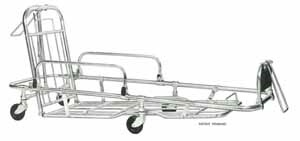 #12 Stretch’R Cot
#12 Stretch’R Cot
 #32 Elevating Stretch’R Cot
#32 Elevating Stretch’R Cot
 #27 Roll In Stretch‘R Cot
#27 Roll In Stretch‘R Cot
Late in 1960 Ferno Manufacturing Company acquired the Washington Mortuary Supply Company. It wasn’t until 1963 that they merged the product lines and the name Ferno Washington, Incorporated was adopted.
The roll-in cot concept was carried one step further in 1967 when Ferno Washington developed the #28 Fernoflex Chair Cot. It was built from rectangular aluminum tubing and the cot configuration converted into a chair. This facilitated using it in small elevators or eased the problem of carrying down stairways with landings or narrow hallways. Many urban emergency squads established the #28 as a standard because of its light weight and mobility in close quarters.
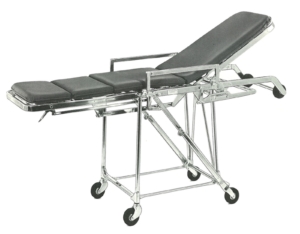 #28 Fernoflex Chair Cot
#28 Fernoflex Chair Cot
In 1970 Ferno Washington designed the York I Cot Bench to meet the need of the market in the United Kingdom. This was single level cot with a long wheelbase that arched over the rear wheel housing. Two York I’s fit in the patient compartment to carry two stretcher patients in the prone position or alternately up to eight sitting patients or invalids.
 Ferno York I
Ferno York I
By 1975 further development of the York I resulted in the Ferno York IV All Level Cot Bench with eight levels of adjustment up to hospital bed height. This was an “X” frame cot, but still met the service requirements of the York I in the ambulance compartment. It was the first elevating stretcher used in the United Kingdom market.
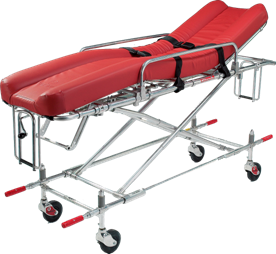 Ferno York IV
Ferno York IV
The American patient handling industry continued to change with greater demand for more equipment inside the ambulance and larger ambulance compartments. The custom built coaches on Cadillac chassis were obsolete with the advent of the modular box on a truck chassis. The station wagon suffered the same demise being replaced by the mini-van. The newer ambulances all increased the height of loading level of the ambulance compartment, making the stretcher lift into the ambulance more difficult. More and more women were coming into the profession and found the high lift difficult. Further complicating the loading challenge was the average weight of the patient continued to increase making the lifting and loading even more challenging.
The demand for the roll in type cot led to the development of the “H” frame Ferno #29 Roll In All Level Ambulance Cot in 1975. It adjusted to four levels with a telescoping lower frame adding stability in the lower positions. It was followed by the Ferno #29-M Roll In All Level Ambulance Cot in 1977 which improve the loading capability for the higher modular ambulances. It still adjusted to allow for level transfer of the patient at the hospital bed level. The basic “H” frame design was further refined in 1993 with the design of the Ferno #93 Squadmate Ambulance Cot.
 #29-M Roll In All Level Ambulance Cot
#29-M Roll In All Level Ambulance Cot
 Ferno 93 Squadmate-ES
Ferno 93 Squadmate-ES
The service requirements in the European market are unique and in 1978 Ferno designed a cot for Holland that proved to be the forerunner of the ambulances cots used throughout continental Europe. The Ferno #50 which was a roll in carrier with a separating stretcher fitted to the top of the carrier. The stretcher top could turn into a chair when not on the carrier. The combination of the two pieces gave you a roll in all level ambulance cot, the top of which could be converted into a chair when removed from the carrier.
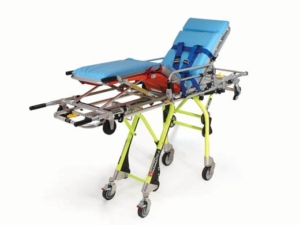 Ferno 50E
Ferno 50E
Various configurations of this combination spread to most European and Scandinavian countries, with unique features and sizes and ultimately to Japan.
Late in 1986 Dyna Med, Inc. designed and brought to market the Hare Any Level/Roll-in Cot. It had the ability of adjusting to any height and one set of its wheels would remain in the swiveling position. It never created enough market demand to get into volume production and was taken off the market in less than a year.

The demand for easier loading cots led to Ferno develop the #35 All Level Roll In Cot in 1993. It was the first “X” frame cot mounted with loading wheels that hinged down to shorten the overall length of the cot. It was a combination of features in the Hare Cot and the original #30 All Level Cot which allowed for loading into ambulance floor levels up to 35”
Ferno 35a
In 1994 The Stryker Corporation of Kalamazoo, Michigan introduced the #6060 LX PRO which was an “X” frame cot similar to the Ferno #35. They followed in 1998 with the #6090 EZ-PRO “H” frame cot similar to the Ferno #93 incorporating a hinged rear leg.
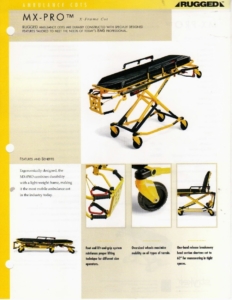

The first long wheeled based “X” frame hydraulic ambulance cot, the Falcon MKI, was developed in 1998 in England by Ferno UK.
It is raised with a hydraulic foot pump and was a further refinement of the York IV All Level Cot Bench. It is the standard of the industry in the UK today.
 Ferno Falcon MKI
Ferno Falcon MKI
Stryker introduced the M-1 Roll In Ambulance Cot in 2000, which was similar to the Ferno #50 to compete in the European market.
 Stryker M-1 System Model 6100
Stryker M-1 System Model 6100
Ferno 50E
In early 2005 Ferno designed and introduced the first battery powered “X” frame cot, the Powerflex. It is capable of raising or lowering up to 700 pounds unassisted to further ease the strain on the ambulance attendants. Stryker developed the Power Pro battery-powered “X” frame cot in 2006 similar to the Ferno Powerflex.
 Ferno Powerflex
Ferno Powerflex
 Stryker Power Pro
Stryker Power Pro

Ferno Today
I went to work in the funeral field at sixteen years of age, when at that time funeral home ran the ambulance service. X frame multilevel cots were the first I used. All of course were two man cots. How even two men could manage the weight of cot and patient in loading and unloading still amazing me. They had to be lifted in and out of the car in the lowest position. We had 1962 Cadillac Miller Meteor Combination cars. They were brand new with detachable lights and the floor boards in the back flipped to make a casket table. Reverse the procedure after a funeral and you were ready for “runs”. Spent many a twenty-four hour shift running and converting back and forth for what ever the demand. Still in the field after 50 years and still have two of the cots for extra cot space in preparation room. – Gary (2014)
Submitted to NEMSM February 2010 by El Bourgraf, additional content by Gary
